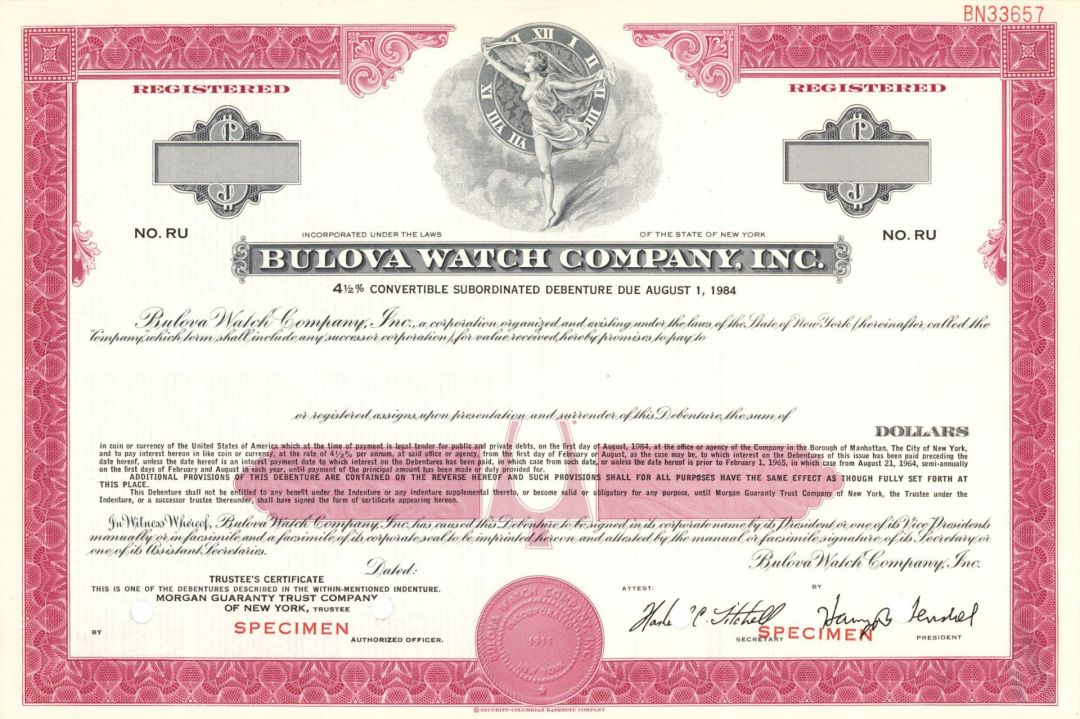Bulova Watch Company, Inc. - Specimen Bond
Inv# SE3649 Specimen BondSpecimen Bond printed by Security-Columbian Banknote Company.
Bulova is an American timepiece manufacturing company that was founded in 1875 and has been owned by Japanese multinational conglomerate Citizen Watch Co. since 2008. The company makes watches, clocks and accessories, and it is based in New York City. Bulova was founded and incorporated as the J. Bulova Company in 1875 by Bohemian immigrant Joseph Bulova. It was reincorporated under the name Bulova Watch Company in 1923, became part of the Loews Corporation in 1979, and was sold to Citizen at the end of 2007. Throughout its history, Bulova developed a reputation for technological innovation and for adapting to the changing needs of customers and the evolving trends of the market. Bulova started a small jewelry shop in New York City around 1875. It was located in New York's Maiden Lane specializing in jewelry and the repair of clocks and the occasional pocket watch. Around 1911 Bulova began producing table clocks and pocket watches. In 1912, Joseph Bulova launched his first plant dedicated entirely to the production of watches. Manufacturing watches at their factory in Biel, Switzerland, he began a standardized mass production new to watchmaking. In 1919, Bulova offered the first complete range of watches for women and men in 1924. The visual style of his first popular advertising made its watches popular with the American public. But beyond the original style, precision and technological research also became imperative for Bulova. In 1927, he set up an observatory on the roof of a skyscraper located at 580 5th Avenue to determine universal time precisely. Bulova established its operations in Woodside, New York, and Flushing, New York, where it made innovations in watchmaking, and developed a number of watchmaking tools. Its horological innovations included the Accutron watch, which used a resonating tuning fork as a means of regulating the time-keeping function. During the 1920's and '30's, Bulova was noted for its art deco watches, which were typically either rectangular or square.Models from this period included the Breton (square or rectangular cases), the Banker (tonneau or barrel shaped), and the Commodore (round cases). All three of these models were modernized in 2020 as the Joseph Bulova Collection, utilizing swiss made Sellita mechanical movements. From 1922 through 1930, Bulova marketed 350 different ladiesâ Art Deco watches, with at least an equal number of models for men. The Westfield Watch Company, Inc. is listed as a Bulova subsidiary at least as early as 1931, but Bulova had trademarked the Westfield name in 1927. Westfields were considered the lower cost options in the Bulova line, since the movements typically had lower jewel counts than mainstream Bulovas, and cases and straps may also not have been of the same quality as other Bulova models. Like the regular Bulovas, the Westfield movements were Swiss made, but the two lines did not use the same movements. Westfield watches were produced at least through the 1950s, with the Caravelle line introduced in the early 1960s. The Bulova trademark of the Westfield name is reported as cancelled in 1989. Read more at https://en.wikipedia.org/wiki/Bulova
Stock and Bond Specimens are made and usually retained by a printer as a record of the contract with a client, generally with manuscript contract notes such as the quantity printed. Specimens are sometimes produced for use by the printing company's sales team as examples of the firms products. These are usually marked "Specimen" and have no serial numbers.










Ebay ID: labarre_galleries